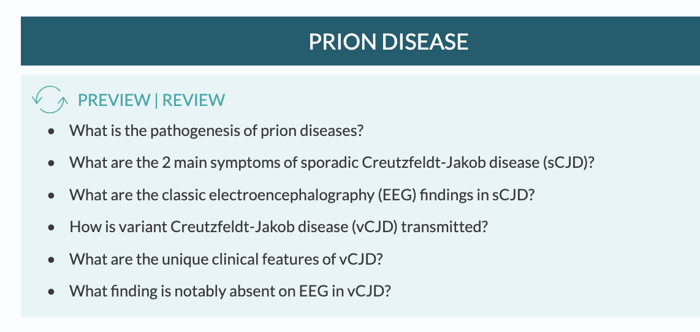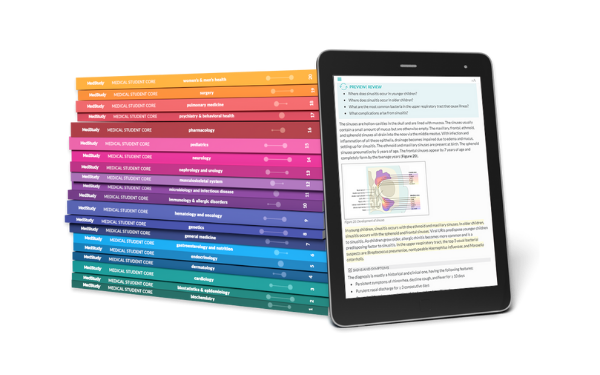5 of the Scariest Things to Learn about in Medical School

There are some of the topics taught in medical school that just make us shudder or give us chills. The below text explains the top five shudder-worthy topics from our Medical Student Core, and, as always, includes high-yield pearls that you might just see on your Step 1 or Step 2 exams.
While you're reading through, you might notice that Signs and Symptoms, Diagnosis, Treatment, and Prognosis are bolded. These special headings help emphasize this information just like it is in the Medical Student Core.
Quick Tip: Before you dive into the content, see if you can answer these Preview | Review questions. If you try to dredge up everything you know about these topics before reading, you'll get the best recall results. We've highlighted the answers for you within the text if you're a skimmer.

Prion disease Preview | Review questions from the Medical Student Core
Prion Disease
Prions are proteinaceous infectious particles that lack nucleic acid and are destructive to neural tissue. There are 5 known human prion diseases, all of which are exceedingly rare, untreatable, and fatal:
1) Kuru
2) Gerstmann-Sträussler-Scheinker syndrome (GSS)
3) Fatal familial insomnia (FFI)
4) Creutzfeldt-Jakob disease (CJD)
5) Variant Creutzfeldt-Jakob disease (vCJD)
All of the prion diseases result in loss of neurons, glial cell proliferation, lack of an inflammatory response, and small vacuoles in the neuropil (dense neurofiber network). The pathogenesis is uncertain but is thought to involve accumulation of an abnormal protein called PrPSc, or Scrapie. We will review all 5 prion diseases here, but note that CJD and vCJD are the most important ones for you to know.
KURU
Kuru was the 1st prion disease to be identified. Kuru was endemic to the Fore tribes in Papua New Guinea, thought to be transmitted via cannibalism prior to the 1950s. Cases have been identified there as recently as 2004; these late cases may be a result of a very long incubation period.
SIGNS AND SYMPTOMS The neurodegenerative symptoms progress through 3 stages: 1) Early or ambulatory phase: tremors (which are like shivering, translated as “kuru”), ataxia, and postural instability 2) Sedentary phase: loss of ambulation, increased tremors, ataxia, myoclonus, and fasciculations 3) Terminal phase: dementia, inability to get out of bed
DIAGNOSIS Diagnosis is histological, with brain biopsy demonstrating “kuru plaques,” particularly in the cerebellum.
TREATMENT There is no treatment for kuru.
PROGNOSIS Patients die within a year of the onset of symptoms.
GERSTMANN-STRÄUSSLER-SCHEINKER SYNDROME (GSS)
GSS is an autosomal dominant inherited prion disorder. There are < 10 new cases per 100 million people each year. About 24 families with GSS have been identified throughout the world.
SIGNS AND SYMPTOMS Affected individuals have progressive cerebellar degeneration, with onset of dementia in their 40s. Patients have additional symptoms of cerebellar dysfunction, such as ataxia, clumsiness, and hyporeflexia. Myoclonus is absent.
DIAGNOSIS Diagnosis requires genetic analysis identifying a mutation in the prion protein (PRNP) gene. Kuru plaques are present in the brain, especially the cerebellum.
TREATMENT There is no treatment for GSS.
PROGNOSIS Death occurs within 5 years of onset of dementia.
FATAL FAMILIAL INSOMNIA (FFI)
FFI is also a genetic prion disorder, caused by a mutation in the PRNP gene. Average age of onset is in the mid-50s.
SIGNS AND SYMPTOMS Patients develop progressive insomnia, with loss of the normal circadian sleep-activity pattern. There are mental status and behavioral changes such as hallucinations and confusion, but not dementia. They go on to develop motor symptoms such as ataxia, myoclonus, parkinsonism, spasticity, and dysphagia. Unique features include endocrine disturbances (e.g., reduced adrenocorticotropic hormone [ACTH], increased cortisol, loss of normal diurnal hormone variations), and dysautonomia (e.g., hypertension, tachycardia, hyperhidrosis).
DIAGNOSIS Diagnosis requires genetic analysis. Brain pathology shows neuronal loss and gliosis, especially in the thalamus.
TREATMENT There is no treatment for FFI.
PROGNOSIS FFI is rapidly fatal, with death occurring within 13 months of onset.
CREUTZFELDT-JAKOB DISEASE (CJD)
CJD is the most common prion disorder, with ~ 1 new case per 1 million people worldwide each year. The mean age of onset is ~ 60 years. CJD is almost always sporadic (sCJD), but ~ 5–15% of cases are familial (fCJD), and < 1% are iatrogenic (iCJD; e.g., corneal transplants, cadaveric human growth hormone). The cause of sCJD is unclear.
SIGNS AND SYMPTOMS Affected patients develop myoclonus and severe, rapidly progressive dementia. Ataxia and visual disturbances also are common.
DIAGNOSIS MRI shows diffuse cerebral disease. EEG classically shows periodic synchronous bi- or triphasic sharp wave complexes. An abnormal protein, called 14-3-3 protein, is sometimes present in the CSF. Brain biopsy is the gold standard diagnostic test.
TREATMENT There is no treatment for CJD.
PROGNOSIS The majority of patients with sCJD die within 6 months of symptom onset.
VARIANT CREUTZFELDT-JAKOB DISEASE (vCJD)
vCJD was first recognized in 1996, with initial cases in the United Kingdom and France. Since then, > 200 cases have been identified worldwide, with the large majority from the U.K. There are no known cases originating in the U.S. Evidence is increasing that suggests transmission occurs via ingestion of contaminated beef that comes from cows with bovine spongiform encephalopathy (BSE), a.k.a. mad cow disease. There have been a few cases of cows with BSE born in Canada, and 1 of them was identified in Washington state in 2003. There are also a few case reports of transmission via blood transfusion in the U.K. In the U.S., the FDA does not allow blood donation from individuals who lived in the U.K. for > 6 years during the peak of BSE (1981–1996). There is no evidence of vertical transmission of vCJD from mother to child.
SIGNS AND SYMPTOMS vCJD has a few features that are different from the other prion disorders. There is an earlier age of onset (mean 29 years), slower progression of disease, different symptoms, and different findings on brain biopsy. The presenting symptoms often are psychiatric, and many patients also have sensory disturbances such as paresthesias. As disease progresses, upward gaze paresis occurs in ~ 50% of patients, and other features include ataxia, dysarthria, and cognitive impairment. All patients are homozygous for modification of the PRNP gene with methionine at codon 129.
DIAGNOSIS Brain biopsy shows amyloid plaques that stain intensely for PrPSc, especially throughout the cerebrum and cerebellum, with surrounding spongiform changes. It also is possible to detect PrPSc in the tonsils and urine. MRI shows a bilateral pulvinar signal, and the EEG does not show periodic sharp wave complexes.
TREATMENT There is no treatment for vCJD.
PROGNOSIS Death occurs in ~ 1 year.
Of course, reading about untreatable, fatal diseases is pretty scary. Thankfully these are all exceedingly rare! What do you think the scariest thing to learn about in medical school is? Let us know. 
Medical Student Core print and digital
Like the Preview | Review feature? How about the Signs and Symptoms, Diagnosis, Treatment, and Prognosis overviews? You can read all of your med school material with these feature. Get the Medical Student Core and start studying now.


